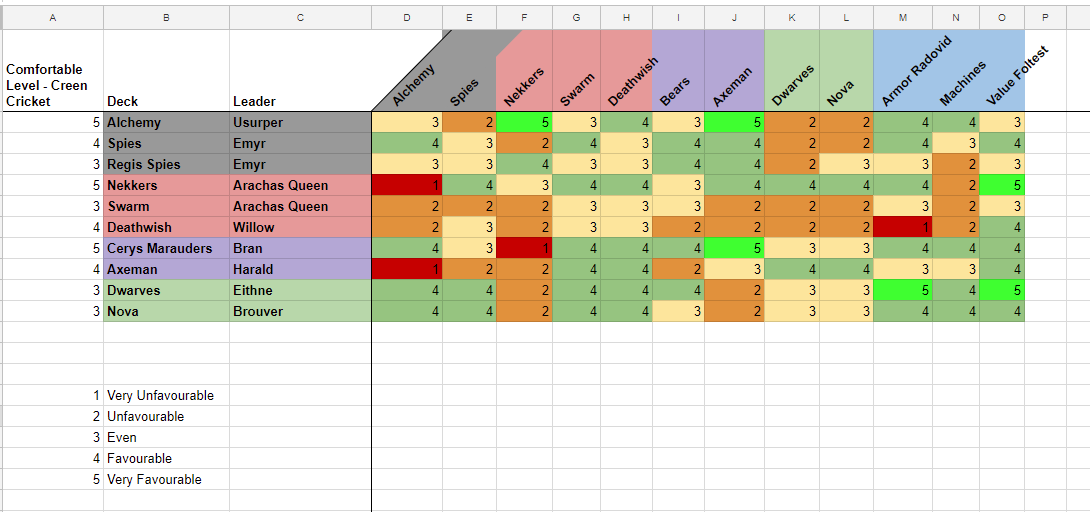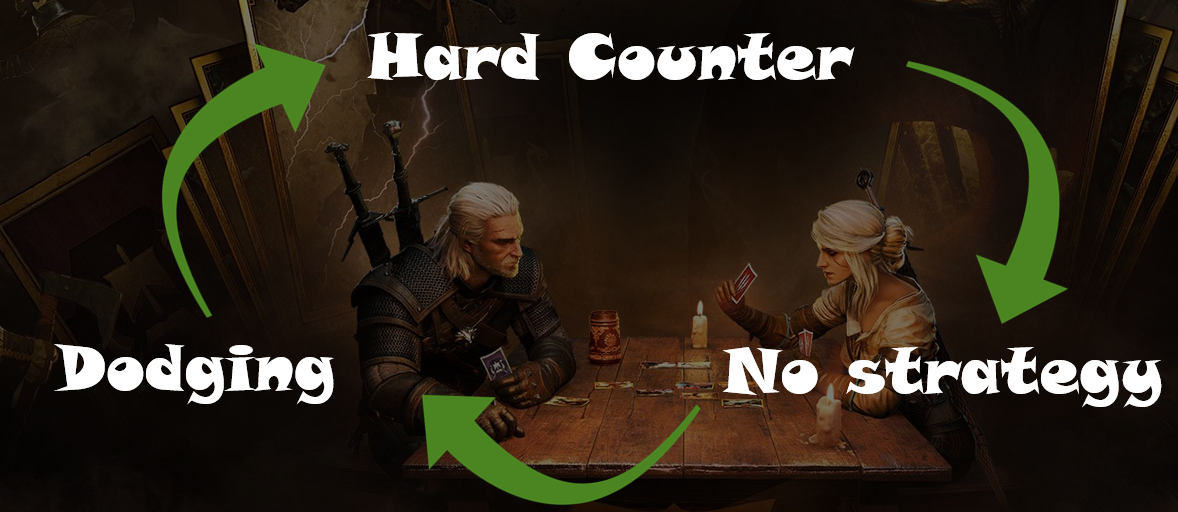
By Green Cricket, February 18, 2018

Winning a tournament requires skill and a bit of luck. If you face similarly skilled opponents you don't want to rely on luck, so let's talk about tournament preparation and how it will give you the edge to emerge victoriously.

3 Steps to prepare for a Conquest Tournament
(if you are not the reading type: we've put together an explanation video, which you can find at the end of the post!)
Step 1: Creating a matchup table
Meta-Analysis
The first question to answer before playing in a tournament is: "What decks are out in the meta?"
There are multiple ways to get a good overview of the meta like:
- Playing a lot of ranked- and pro-ladder
- Analyzing the Gwent Up Meta-Analysis
- Researching GwentDB decks
- Watching high MMR streamers
- Watching online tournaments
Then we take the gathered information and put the current meta decks into an Excel table.
Select decks for the tournament
The next step is to determine, which decks we want to bring to the tournament.
Always select decks, which you are comfortable to play with!
It does not make sense to bring a new "very powerful" deck to the meta, if you don't feel comfortable playing with it or if you can't pilot it perfectly.
We open up our Matchup table and add the decks, we want to play, as rows.
Include the leader, add a descriptive name and I personally also include my comfortable level, which is a scale from 1-5, telling me how comfortable I am playing this deck.
Take into consideration:
- Your ability to pilot the deck
- The consistency of the deck or how much RNG is required to make it happen
- Your general gut feeling about it
Filling the matchup table

Now comes the interesting part, even though it is a bit of work:
We'll go through every row of our table and add into it how favourable our deck is against the decks we noted down before.
The numbers from 1 to 5 would translate into: Very Unfavourable, Unfavourable, Kinda Equal, Favourable, Very Favourable.
Think of counters (like Sweers against Nekkers, Removal against Engine Decks, etc.) and talk with friends and other Gwent players to look at the table together with you.
Maybe they have some valid input, which you oversaw.
In the end, however, it is you who decides on the number, because you need to play the matchups in the tournament.
Picks & Bans
Now we have a table with good and bad matchups and some comfortable numbers.
Analyze the table intensify and check if there are certain decks, which are very unfavourable against decks you might wanna play.
Those will become potential bans.
Then check your decks (keep your comfortable level with them in mind!) and check if they are favourable against most of the other decks.
Those will become potential picks.
Step 2: Choose a tournament strategy
Depending on the format of the tournament, there are different strategies to nail down picks and bans, so keep in mind that this article focusses on Conquest tournaments!
Conquest means that you'll bring 4 leaders, you then ban one of your enemies and then you'll have to win with every one of your leaders.
There are three basic strategies to approach Conquest:
- Hard counter one deck
- Dodging a counter
- Use the ban to enable certain sleeper deck
1 - Hard Counter
Let's start with hard countering one deck, which is what SuperJJ did against Kolemoen in the last Gwent Open.
Since you need to win with every single deck in Conquest, it does not matter if an enemy goes 2-0 on you, because as long as he can't win with his last deck, then you win the tournament round. For example, if your enemy brings Consume, you can adapt your decks, so all decks are very favourable against Consume, which will make it very hard for your enemy to win with that deck.
This is a very strong strategy if it works out, but it can be risky if your opponent runs an unconventional line up or he is able to sneak in a win because you have a bad hand.
2 - Dodging
This is the contra strategy if you expect an enemy to use "Hard Counter".
In the case above, if an enemy teches actively against Nekker Consume, you could bring Swarm Consume or Arachas Queen with a totally different deck behind it to make their tech choices less efficient.
The benefit of this strategy is that the enemy has weakened their decks by tech choices, which don't hit you that hard anymore, but the downside is, that if your opponent doesn't try to counter and just plays a very strong autonomous deck, then you may have a disadvantage.
Rock, Paper, Scissors
Those two strategies in addition to "no strategy at all and just bringing strong decks to the tournament" work in a rock, paper, scissors way.
Countering beats Strong Decks, Strong Decks beats Dodging and Dodging beats Countering.

3 - Sleeper Deck
However, there is a third strategy, which is using bans to enable certain sleeper decks.
Let's say we believe that Greatswords is a very good deck, which is not common and no one would expect it.
However, we know that Greatswords has a very tough matchup against spies if the spy player knows what he is doing.
So you could ban spies and then tech your whole deck against the other meta choices.
This works really well if you find a deck which is really different from the rest, but it doesn't make sense to just bring a very weak deck to a tournament, just because nobody is expecting it, even if you tech accordingly.
General strategy advice
Make sure not all three of your decks are really different because this makes it easier for your opponent to find the one deck to counter against.
If your enemy has one deck that counters all three of yours, then don't be afraid. As soon as he wins with that, the deck is gone for the rest of the matchup.
Better have an enemy with 1 deck countering all of yours, than an enemy having 3 decks to counter exactly 1.
Step 3: Teching
This is so to say the meat of tournament play and something which is often done wrong by beginners because a tournament is entirely different than the ladder.
On ladder you look for one strong deck and just grind it, while in tournaments you also need to win with your "weaker" decks.
On a basic level, teching just means switching cards in your deck, so your deck becomes more favourable in the tournament, because of what you think will be played in there.
Of course, most decks have some kind of card skeleton, meaning that in a Spy deck, you'll probably want to include emissaries and brigades.
But except the skeleton, you always have the ability to change out some cards, because ranked (net)decks are tailored to counter the other decks played on the ladder.
And you really should do this because newer players tend to pick decks they can afford, decks that streamers recommend, which rank high on GwentDB, which have been played in recent tournaments and so on.
Depending if you use a Countering, Dodging or another strategy, you want to exchange your "flexcard-slots" accordingly.
Typical Tech cards:
- Artefact Compression and Muzzle
- Against decks with strong bronze units, like Impera Brigades and Nekkers (Artefact Compression)
- Able to deny an enemy strategy (like a Slyzard target)
- Scorch Effects
- Good against high unit decks like Spies, Ciri: Nova and others
- Reset (Mardroeme, Mandrake, Peter Saar Gwynleve, etc.)
- Perfect for denial and to obliterate buffed up units (Joachim de Wett targets, Vran Warriors, Nekkers, etc.)
- AOE (Lacerate, Stammelford's Tremor, etc.)
- Best value against Swarm decks
- Graveyard Hate (Vicovaro Medic, Caretaker, etc.)
- Denies resurrection targets / strategies
- Steal that enemy Olgierd von Everec!
- Assire var Anahid
- Denies resurrection targets
- Can fill the enemy deck with trash cards
- Weather & Clear
- Weather is good in meta with less weather (no clear is played) and vice versa
- Hazards are great against boon decks because they overwrite the boons
Of course, there are more, but this should give you a general impression.
If your tech then bear in mind, that usually opponents end up with playing their strongest or more consistent deck as their first deck in a matchup, because they are looking, for an easy win.
Summary
The first and most important step is always creating the matchup table, which you'll need for all of your decisions afterwards!
Then we pick a strategy for the tournament and then we tech according to the picks and bans and our strategies.
If you scrolled down, because you don't have the time or motivation to read that much, then check out our explanation video:

Author
Green Cricket
Green Cricket is one of the heads of Aretuza, creating an environment where players and content creators can thrive and continuously improve themselves. In addition to his work at Aretuza, he runs a Gwent YouTube channel for beginners and advanced players alike. He teaches how to become better at Gwent and offers one in-depth Gwent guide each week as inspiration.




